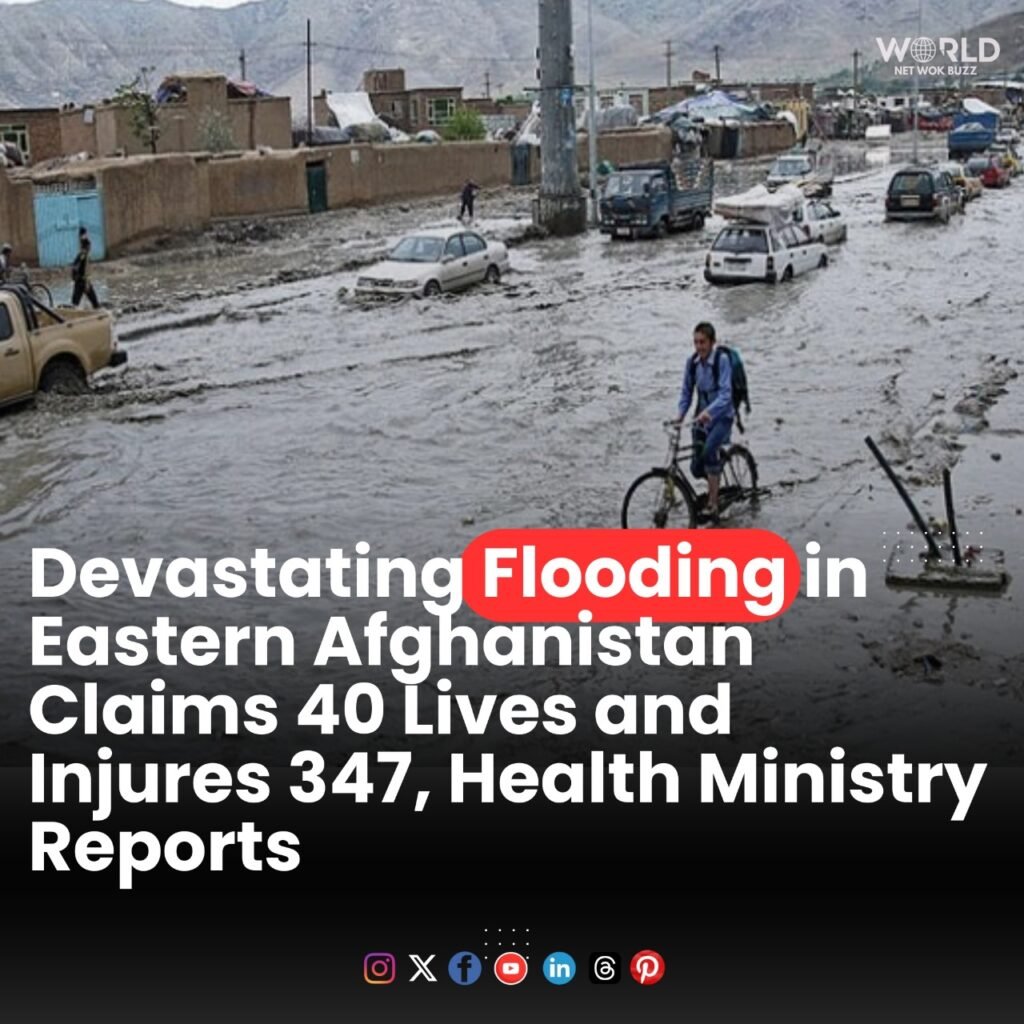Eastern Afghanistan Devastated by Deadly Flooding
The devastation caused by torrential rains has reached eastern Afghanistan. 347 people have been hurt and almost 40 lives have been lost as a result of flooding, according to the health ministry. Families are in disarray, communities are in disarray, and emergency workers are overworked as a result of this terrible incident.

The Immediate Impact
Many were taken by surprise when the water suddenly started. Roads were washed away, homes were submerged, and livelihoods were lost. Lovers were carried away or stranded amid rising seas, tearing apart families. The sobering data provided by the health ministry just scratch the surface of the human cost, highlighting the suffering endured by the survivors, the loss experienced by the deceased, and the pressing need for assistance and medical attention.
Stories of Survival
Stories of survival—acts of bravery and tenacity that shine through the gloom—appear amid the dejection. Communities coming together to save kids from flooded houses, strangers creating human chains to reach people stuck in dangerous places, and medical personnel putting in endless hours to treat injured people in spite of scarce resources. These stories highlight how resilient people can be when faced with hardship.
The Role of Community and Solidarity
Communities have united in the face of such tragedy. Improving shelters have appeared to accommodate the refugees. Not only are relief agencies distributing food and necessities, but neighbors are also sharing what little remains. This show of support is evidence of the strong ties that bind Afghan society together despite differences in ethnicity and culture.
Challenges in Relief Efforts
The government’s response has been scrutinized, with criticism over preparedness and coordination. Calls for improved disaster management strategies echo amidst the chaos, highlighting systemic weaknesses that must be addressed to better protect vulnerable populations in the future. Despite efforts to mobilize resources, bureaucratic hurdles and logistical constraints have impeded swift action.
International Support and Aid
International relief organizations have quickly sprang into action to contribute knowledge, resources, and funding. This cooperative endeavor demonstrates the international community’s support for Afghanistan during its difficult period. But making sure that help reaches the people who need it most is still a logistical problem made worse by bureaucratic roadblocks and security worries.
Psychological Impact on Survivors
In addition to the physical destruction, survivors of the deluge have a severe psychological scar. Many people struggle with trauma, lamenting the passing of loved ones and trying to piece their broken lives back together. In the immediate wake of a tragedy, mental health care is often disregarded, which exacerbates the long-term difficulties that people and communities confront.
Economic Repercussions
The flooding has a significant financial impact, especially on disadvantaged people that are already struggling with poverty. Homes and livelihoods have been taken away, leaving many people without the means to sustain themselves. The path to recovery will be difficult; in addition to urgent assistance, possibilities for sustainable livelihoods must be provided in order to rebuild communities and bring about economic stability.
Lessons Learned for Future Preparedness
Lessons from this unfortunate occurrence must be taken into consideration as Afghanistan starts to heal. To reduce the number of lives lost and the loss of livelihoods in the future, investments in disaster preparedness and mitigation measures are crucial. Future natural catastrophe damage can be reduced by fortifying early warning systems, boosting community resilience, and strengthening infrastructure resilience.
Environmental Concerns
The flooding also raises environmental concerns, highlighting the vulnerability of ecosystems to extreme weather events exacerbated by climate change. Addressing environmental degradation and promoting sustainable development practices are critical to reducing the risk of future disasters and safeguarding natural resources for future generations.
Long-Term Recovery and Reconstruction
Resources and a consistent commitment are needed for community reconstruction. Long-term rebuilding efforts should put infrastructure repair, housing reconstruction, and the restoration of access to basic services like healthcare and education at the top of the priority list, in addition to emergency relief operations. International assistance will be essential throughout this protracted healing period.
Hope and Resilience
Signs of optimism appear in the middle of the destruction. Communities coming together, people displaying incredible resiliency, and the Afghan people’s unwavering spirit shining through hardship. The ability of a country to emerge from the ashes stronger and more unified than before, rather than its ability to prevent calamities, is what truly reveals the strength of that country in these kinds of situations.
Moving Forward Together
Afghanistan faces problems ahead, but it also has potential for progress and rebirth as it rebuilds its broken lives and laments its losses. Navigating the challenging path ahead will need international unity, local resilience, and a shared commitment to creating a more resilient future. By working together to create a safer, more prosperous Afghanistan for all, we can pay tribute to those who have died.






